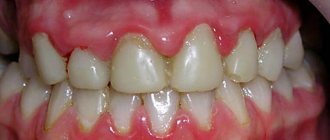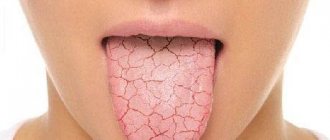Main symptoms
Sometimes the presence of cracks and grooves in the tongue is not accompanied by unnatural or painful sensations and can only be detected during examination by a dentist, ENT specialist or therapist. But this doesn't always happen. Patients often complain of the following related problems:
- pain;
- burning sensation;
- feeling that the tongue is loose;
- there is blood and ichor;
- elevated temperature;
- swelling and itching appeared;
- it becomes painful to chew;
- there is a problem with speech;
- increased salivation appeared;
- change in natural color;
- taste disturbance;
- the appearance of an unpleasant odor.
If cracks appear on the tongue, and the phenomenon is accompanied by one of the listed symptoms, then they speak of a progressive disease. This inflammatory process is referred to as glossitis; the prognosis for recovery from it is usually favorable. The appearance of erosions, furrows and ulcers indicates damage to the deep parts of the tongue. In this case, you should definitely contact a specialist.
Sometimes the tongue cracks and becomes covered with ulcers due to general damage to the ENT organs. Thus, tonsillitis or fungal pharyngitis can cause swelling and the appearance of white grooves. This condition is not isolated as an independent disease. Treatment in such cases begins with eliminating the underlying problem.
How to understand whether a tongue frenulum is short or not? Symptoms of dysarthria
Author: Olga Sakharovskaya, speech therapist-practitioner, specialist in speech therapy, probe, fascial massage and myofascial centering.
Most often in practice these two violations occur separately, less often together. Parents come to me for consultation with complaints that a child of 3 years old does not speak and he is diagnosed with motor alalia (the parents are in a panic, since they have already been on the Internet and Googled it). Or a child’s speech at 4 years old is incomprehensible, he has “porridge” in his mouth, cannot pronounce some words, and he is diagnosed with delayed speech development (also panic, since we have read all sorts of horror stories on the forums).
Or maybe the reason is a short frenulum of the tongue, it needs to be trimmed and then the child will speak? I ask what the child’s neurological progress is? What does the neurologist diagnose? And everything is fine in the child’s chart, the neurologist writes: healthy. I'm starting to explore. And it turns out that the primary cause of sound pronunciation disorders or lack of speech is dysarthria.
As a rule, dysarthria has minimal manifestations or an erased form, less often a moderate form, and even less often a severe form. It happens that two disorders are combined: short frenulum and dysarthria. With this option, the tongue is inactive, as a rule, muscle tone is increased (spastic) and movements are limited.
In addition to using tests for dysarthria, I examine the structure of the articulatory apparatus and look at the following criteria: tempo, switchability of movements of the tongue and lips, whether the child maintains a given articulatory position, assess the prosodic system (voice, breathing), assess the state of the muscle tone of the tongue and the state of the hypoglossal ligament/ bridles. I conduct the examination in the presence of the parents, and at the same time I explain what I am doing, why and why this happened to the child. At the end of the consultation, I answer the most important questions.
Which is not affected by the length of the bridle.
- On the formation of the communicative function.
- For delayed speech development.
- On the formation of the grammatical structure of speech.
It is important to know!
- The length of the frenulum influences the formation of the correct phonetic structure of the sounds of the upper instep: R, Rb, Sh, Zh, Ch.
- The length of the frenulum affects the formation of the bite.
- The length of the frenulum affects the volume and usefulness of tongue movement in the oral cavity (sucking, chewing, swallowing).
The main signs of a short frenulum:
- The tip of the tongue is attached to the floor of the mouth: this significantly limits its mobility.
- The frenulum is shortened in the anterior part, often representing a transparent thin film, devoid of blood vessels. As the film matures, it becomes denser and blood vessels form in it.
- The tongue folds into a groove or “heart” shape, which produces a characteristic clicking sound.
What the numbers say:
- The incidence of a short frenulum of the tongue is 1 case per 1000 newborns.
- In boys, a short frenulum of the tongue occurs 3 times more often than in girls.
Modern surgery offers to perform frenuloplasty using a laser:
- This is a bloodless procedure lasting no more than 10 minutes.
- During the manipulation, the vessels of the mucous membrane are welded together and do not require a suture.
- The laser has a bactericidal effect.
- The recovery period is very short.
- No scars form under the tongue.
- The child will forget about the procedure the next day. There are pathologies of the frenulum that require more serious surgical intervention with sutures (the surgeon chooses the method of correcting the frenulum).
Modern speech therapy in most cases suggests pulling the frenulum. What is my opinion, cut or pull?
After an in-person examination, I determine a course of action and discuss possible options with parents:
- Pull the hyoid ligament using special speech therapy articulation exercises and massage techniques. This process can take from 1 month or longer (I’m giving real correction times based on my 20 years of practical experience), provided that there are visits to a speech therapist 2-3 times a week.
- Prepare the articulatory apparatus for surgical intervention (I use special massage techniques to work the floor of the mouth, release clamps, remove tension, relieve spasticity from the muscles of the neck, face, tongue).
- Refer to a surgeon for plastic surgery of the lingual frenulum.
- After 7-10 days, continue speech therapy work on speech correction, which includes points No. 1, 2.
Types of glossitis
In total, there are more than ten types of glossitis, three of which are accompanied by the appearance of cracks in the tongue. They have quite pronounced visible differences. To independently diagnose the type, you can compare the current state of the tongue with photos of classic manifestations of the disease.
Folded glossitis takes its name from the main external manifestation - the presence of folds. Sometimes, with this type of disease, a cracked tongue is present from birth. If it does not hurt, is not loose and there are no other unpleasant sensations, then the condition is considered normal. However, with deep cracks in the tongue, treatment is still necessary.
The problem of a folded tongue is often only of an aesthetic nature, although people with this feature are recommended to have constant monitoring by a dentist.
Desquamative glossitis is characterized by focal damage to the surface with almost imperceptible shallow cracks. The papillae desquamate and a whitish heterogeneous layer forms. The affected areas quickly recover, acquiring a natural color, and those adjacent to them become inflamed. The geometry of white areas (plaque) on the surface often changes. In advanced cases, due to the large number of cracks, a person feels the tongue is loose.
Diamond-shaped glossitis is characterized by the presence of a rhombic or oval-shaped area of red-blue color. It is located in the middle of the tongue, in the region of the posterior third. The tongue cracks in the center, so that the entire affected area seems to be divided into two parts. This type can be chronic, and during exacerbations, pain and burning begin.
Glossitis - symptoms and treatment
Folded or scrotal tongue. The term “scrotal tongue” comes from the external similarity of the affected tongue to the skin of the scrotum (from the Latin scrotum - scrotum). With this form of glossitis, a deep central groove runs along the back of the tongue with adjacent cracks and folds, which can be located longitudinally or randomly. The tongue is slightly enlarged [5]. Due to atrophy of the filiform papillae, it may look “smoothed out”, but this does not affect the taste sensation [16].
Diamond-shaped or median glossitis. This is a chronic disease of the mucous membrane of the tongue with partial or complete absence of filiform papillae closer to the posterior third of the tongue. The lesion has a diamond shape, a dense texture and a red varnished color. Usually it has clear contours and does not protrude above the mucous membrane. The lesion does not cause pain, but some patients perceive it as an aesthetic defect.
Other forms of rhomboid glossitis are less common - with tuberous outgrowths and papillomatous growths. The patient then feels the presence of a foreign body on the tongue [5][16].
Desquamative or “geographical” language. With this form of glossitis, the keratinization of the tongue is partially disrupted with signs of desquamation of the epithelium - desquamation (Latin desquamo - remove scales). The papillae of a significant part of the surface of the back of the tongue are changed. The lesions take on the appearance of red spots with a diameter of 0.5 cm and desquamated whitish epithelium along the edges. The spots can merge with each other and create a pattern similar to a geographical map.
Patients often complain of pain and burning when eating food or drinks that irritate the oral mucosa, and some of them note a short-term loss of taste.
There are two forms of desquamative glossitis: migrating and fixed [16].
The fixed form is more common with moderate damage to the stomach by the bacterium Helicobacter pylori. The disease is usually accompanied by persistent atrophy and smoothness of the filiform papillae of the tongue. The size and location of the lesions does not change.
The migratory form occurs when the stomach is heavily colonized with H. pylori. Foci of desquamation are up to 2 cm in diameter, their location is constantly changing.
Also, with desquamative glossitis, the tongue may increase in volume due to inflammation of the fungiform papillae, which are located at its root. They reach 0.8 cm in diameter and are covered with a white or light gray dense coating [14].
Black "hairy" tongue. This is a rare lesion in which the keratinized epithelium of the filiform papillae located in the posterior and middle third of the dorsum of the tongue does not slough off. Because of this, the papillae acquire a brown or black color, become stiffer, grow up to 2-3 cm, and are covered with a coating ranging from green and light brown to black [16].
The tongue takes on an unaesthetic appearance, patients complain of the sensation of a foreign body in the mouth and the appearance of a gag reflex [4].
Diseases of the gastrointestinal tract. A sign of damage to the gastrointestinal tract is a grayish-white coating on the back surface of the back of the tongue. There are no pain or any other subjective sensations.
Another manifestation of gastrointestinal tract damage is swelling of the tongue with tooth marks on its lateral surfaces without visible relief disturbances. At the same time, patients may be bothered by constant biting and burning when eating hot and spicy foods. The fungiform papillae located at the root of the tongue may also enlarge. They become bright red and rise above the surrounding tissue. The listed symptoms may accompany gastritis, gastric and duodenal ulcers[5].
With hepatitis A, areas of desquamation appear on the back of the tongue. Due to atrophy of the filiform papillae, the tongue becomes smooth and red. Patients often complain that the taste of sweet and bitter foods has become less pronounced [5].
Liver cirrhosis is manifested by swelling of the sublingual veins, atrophy of the oral mucosa and deepening of the natural folds of the tongue.
Lesions of the pancreas. In acute pancreatitis, the tongue becomes covered with a yellow-white coating, and the filiform papillae increase in size. Patients are often concerned about its dryness and disturbances in taste sensitivity.
In chronic pancreatitis, a secondary deficiency of B vitamins occurs, which is manifested by pain in the tongue and protruding bright red fungiform papillae. The tongue increases in size, becomes smooth and shiny.
Cardiovascular pathology. With hypertension, blisters with bloody contents are often present on the tongue, the so-called “vesical” symptom. They can suddenly appear and burst on their own, damaging the epithelium.
Diseases of the endocrine system. With diabetes, the body is dehydrated, so dryness appears, and the vessels of the tongue become overfilled with blood. A burning sensation occurs and long-healing ulcers form. Very often, symptomatic candidiasis is found on the tongue, especially if the patient does not regulate blood glucose levels.
Insufficient function of the thyroid gland, or hypothyroidism, leads to enlargement of the entire tongue or part of it and swelling, which does not form a dimple when pressed. Due to high cholesterol levels, the tongue is slightly yellowish in color.
Diseases of the blood and hematopoietic organs. With iron deficiency anemia, there is a need to eat unusual substances, such as chalk, clay, as well as a burning sensation and pain in the tongue. It is often pale in color and slightly increased in size.
With Addison-Beermer anemia, which occurs due to impaired absorption of vitamin B12, the filiform muscles weaken. The tongue becomes smooth and as if “polished”. This condition was called “Gunter's glossitis.” Painful red inflammatory streaks and spots appear. The tongue or just its tip turns bright red, and a tingling and burning sensation occurs [5].
Acute leukemia is manifested by ulcers of irregular shapes without clear boundaries with a necrotic coating on the tongue, without rims of hyperemia (overflow of blood vessels) along the edges. Pinpoint and small blood spots and hematomas may also appear on the mucous membrane of the tongue. One of the main symptoms of this condition is heavy bleeding.
Chronic leukemia occurs much less frequently than acute leukemia and lasts longer. Characteristic ulcers and leukemic infiltrates (fluid accumulation) appear on the tongue. At the acute and chronic stages of leukemia, they lead to the formation of ulcerative-necrotic lesions, which are difficult to treat.
Agranulocytosis is characterized by a significant decrease in the blood of granulocytes - a type of leukocyte, “protective” blood cells. The disease manifests itself as non-demarcated ulcers on the tongue and, unlike acute leukemia, an inflammatory reaction around them. Due to decreased immunity and the resulting increased susceptibility of the body to fungal diseases, candidiasis may develop.
Changes in the tongue due to hypo- and avitaminosis:
- hypovitaminosis A - dryness of the mucous membrane of the tongue and a tendency to increased keratinization of the skin (hyperkeratosis);
- hypovitaminosis C - swelling of the tongue with teeth marks on it; ulcerative necrotic lesions, usually covering a significant surface area of the tongue mucosa;
- hypovitaminosis PP causes a disease called “pellagra”, in which peeling of the surface layers of the epithelium occurs and a burning sensation of the tongue, it becomes smooth, shiny and crimson - the so-called “cardinal tongue”;
- hypovitaminosis B1 is characterized by pain in the tongue and the appearance of blisters;
- hypovitaminosis B2 is manifested by burning of the tongue, atrophy of the papillae and angular cheilitis - cracks in the corners of the mouth [4].
When infected with herpes simplex virus type 1 (HSV-1), patients complain of burning pain in the tongue. Upon examination, a deep crack is visible along its midline with several branches. In their depths there are painful blistering rashes, which over time burst with the formation of erosions.
Burning mouth syndrome. In the area of the tongue there is a feeling of a burn, paroxysmal burning pain, which intensifies with overwork and stress.
Galvanism. Patients experience a metallic taste in the mouth and rawness. Upon external examination, the tongue is swollen, its vessels are filled with blood, “bald spots” of the papillae and bright red erosions appear on its sides [5].
Localization of cracks
The position of the cracks is not random. Localization is divided into three types, each of which is caused by specific problems. You can independently identify the type of localization by assessing the position of the cracks in the tongue: in the center, on the sides or at the tip.
The presence of cracks only at the tip of the tongue indicates the following causes of the problem:
- Thermal damage. Hot food first comes into contact with the tip of the tongue and causes major damage to it. Often the problem is contact with a hot metal spoon.
- Chemical damage. Occurs from contact with spicy, sour foods or corrosive substances.
- Physical impact. The tip can crack due to an incorrect bite or a cut on the sharp protruding parts of the incisors and canines.
Photo: cracks on the sides of the tongue
The formation of cracks in the tongue in the middle has a different reason, since it is almost impossible to injure this area without touching the periphery. This means that inflammation is an indicator of pathology or disease of internal organs. In addition, the formation of cracks in the center is possible when the middle area dries out, local circulation is impaired, or the immune system is weakened. There may be only one crack; upon examination, it appears as if the tongue has split into two parts.
The presence of cracks on the sides of the tongue can be caused by various reasons. If the inflammatory process is present on the side on one side, then this means physical damage from the sharp edges of small and large molars or dentures. If the tongue is cracked on both sides, it means that there are serious malfunctions in the functioning of the body , where glossitis acts only as an indicator of pathology.
Causes of cracks
Folded glossitis can be detected immediately after the birth of the child. The cause is most often a hereditary predisposition, rather than a sign of any disease. Therefore, if a child has a cracked tongue, this is not yet a reason to start urgent treatment. Only if the grooves bleed or other problems are present should you seek medical help.
The causes of cracks in the tongue can be very different, but they all require diagnosis and elimination. The first type of prerequisites is of a dental nature; the problem arises due to the following phenomena:
- cuts to the organ by sharp edges of teeth or an incorrectly selected prosthesis;
- if diseases of the oral cavity or ENT organs are not treated for a long time;
- irritation from eating excessively hot, spicy, salty or sour foods;
- allergic reaction to medications or toothpaste taken.
The second type of reason, which explains why cracks appear on the tongue, can be described as indicator. It indicates the presence of a disease of the organs or circulatory system.
Another reason for the appearance of cracks in the tongue in adults may be a banal vitamin deficiency, leading to a decrease in immunity. It is usually observed in the following cases:
- the onset of the period from February to April, when there is no supply of vitamins from fresh vegetables and fruits for a long time;
- period of growing up with changes in hormonal levels;
- breastfeeding period.
What causes a white coating on the tongue?
Generally speaking, among the most common causes of plaque:
- Infectious diseases. With them, pathogenic microorganisms begin to multiply at an unprecedented speed. Hence - weakness, painful symptoms and altered condition of the mucous membranes.
- Immune failures. If the immune system does not begin to work at full strength, conditionally pathogenic microflora is activated. Then disturbances in the activity of the stomach occur, the tongue turns white due to abundant deposits of plaque.
- Diseases of the stomach and intestines. They can be acute or chronic. Most often they occur due to the spread of Helicobacter. With enterocolitis, plaque appears on the root of the organ; with gastritis, it covers the entire tongue.
- Side effects of drug therapy. Antibiotics are especially aggressive. They suppress the growth of pathogenic bacteria, at the same time disrupt the acid-base balance and destroy beneficial flora.
- Tobacco smoking. Smokers' tongues are usually white, yellow or gray. Nicotine has a detrimental effect on the microflora of the mouth and the entire body as a whole.
- Helminthic infestations. If parasites appear in the body, the condition of the oral cavity may worsen.
Medical assistance
If the tongue is cracked and hurts, is swollen on the sides, or there are other signs of the progressive development of the disease, then treatment must be started immediately . A protracted process can progress to a more complex stage, up to necrosis or oncology.
Constant inflammation causes intoxication of the body and is fraught with the entry of pus into the gastrointestinal tract.
Only a doctor can give a qualified answer to the question of why the tongue cracks. Due to the variety of possible causes of cracks in the tongue, the problem arises of which doctor to contact in order to establish the correct diagnosis and prescribe adequate treatment. First of all, you need to get examined by a dentist. This is necessary to identify prerequisites associated with problems in the oral cavity, or to exclude such a scenario.
If, as a result of a dental examination, the cause of cracks in the tongue was not identified, this means that the problem may be caused by diseases of the internal organs. Usually the patient knows or guesses from how he feels about its existence. Depending on the type of possible pathology, you need to contact a specialized specialist.
If there are no obvious signs of illness, you need to consult a therapist or pediatrician. You can first take a general blood test and do an ultrasound of the internal organs.
The nature of white coating on the tongue
Unfortunately, white tongue is not always the norm.
Moreover, most often it indicates malfunctions in the functioning of internal organs. But this does not mean that all people who notice a light “mush” on the organ of taste should urgently rush to see a dentist or therapist. There are two situations where you don't need to worry about coated tongue:
- The symptom appears in the morning (immediately after waking up). Most people have a coating on their tongue after the night. There's nothing wrong with that. Bacteria living in the oral cavity multiply actively. The speed of their spread is especially high if a person ate something sweet or drank alcohol in the evening. A thorough morning toilet will put everything in its place.
- The symptom appears soon after eating. If a person ate blueberries, drank strong tea or coffee, wine, a change in the shade of the mucous membranes is not a deviation. Soon the pink color will return on its own. Sometimes this just requires brushing your teeth or performing a hygienic rinse. If the meal was not associated with the consumption of products containing chemical and natural dyes, but the shade of the muscle organ changes each time, you will still have to consult a doctor.
Therapeutic treatment
First of all, to get rid of glossitis, it is necessary to diagnose and determine the nature of its occurrence, since it is impossible to cure cracks in the tongue without eliminating the provoking factor. The treatment method should be developed by a specialist in the underlying disease. Additionally, symptomatic treatment of the entire oral cavity is used, depending on the type of lesion. To do this, use the following methods:
- drug therapy aimed at improving local blood circulation in the tissues of the oral cavity;
- prescribing physiotherapeutic procedures such as electrophoresis;
- use of antiviral ointments;
- the use of drugs that stimulate epithelial restoration;
- taking antibiotics for fungal complications;
- administration of local anesthetics for severe pain.
Indications for surgery
Abnormal frenulum length is corrected surgically. Surgery at an early age is indicated in the following cases:
- when the baby has difficulty sucking the breast;
- when a child begins to develop an abnormal bite;
- when a displacement of the dentition occurs in the baby’s oral cavity;
- even if the speech therapist cannot help the child correct speech defects.
Up to a year, the frenulum is cut with scissors and stitches are applied if necessary. The operation is performed quickly and painlessly, since there are no nerve endings in the frenulum.
Preschoolers and children of primary school age also have their frenulum cut, but a little differently. The frenulum is cut with a special scalpel, and the attachment site is moved to another place and sutures are applied.
Teenagers' bridles are not cut. A speech therapist works with them, and the dentist prescribes special exercises to stretch the frenulum.
Correction of the frenulum can also be indicated for patients in adulthood (at one of the stages of orthopedic treatment).
Use of traditional medicine
At home, you can use well-known methods to help heal wounds in the mouth, eliminate pain, relieve swelling and other symptoms. However, before treating cracked tongue with folk remedies, you need to ensure their compatibility with the prescribed medications.
The most effective are the following recipes:
Herbal infusion of chamomile, celandine, sage and calendula. For adults, you can add St. John's wort. Take after meals in the form of baths or lotions. Promotes wound healing and relieves swelling.- Compresses from fermented milk products. Soften scars and scabs. The procedure should be done in the morning for 15 minutes.
- Sea buckthorn or olive oil. In the morning you need to drop a few drops on the mucous membrane and in the middle of the tongue, then do not drink or eat for 15 minutes. Softens dry formations on the tongue and mucous membranes.
- Honey. Has wound-healing and antimicrobial effects. A piece of the product can be placed in the middle of the tongue and dissolved. Gives a good effect if cracks bleed.
- Propolis tincture (for adults only). The strongest disinfectant: has antimicrobial, antibacterial and anti-inflammatory effects. Since alcohol tincture cannot be used in its pure form if there are open wounds, you need to dilute 1 teaspoon in 100 grams of warm tea. Drink after meals.
Treatment
Therapeutic dentistry is effective when a provoking factor is detected. After all, blisters and other lesions are the result of a malfunction of organs or systems. By eliminating the cause, its pathological consequence will disappear.
- Local treatment and sanitation of the oral cavity are required. Modern drugs are used.
- The mechanical irritant, that is, the prosthesis, filling, crown, is eliminated.
- The nervous system is strengthened through sedatives and medications, which stimulates cerebral circulation.
- The diet is adjusted to restore metabolic processes;
- Preventive measures for gastric diseases are prescribed.
- Hormonal drug support may be required.
At home, the patient takes the tablets prescribed by the doctor and rinses with chamomile infusion. Nonsteroidal drugs, stimulators of epithelial cell regeneration, antibiotics, antifungal and viral agents, and vitamins may be required. If an allergy is detected, the patient takes antihistamines. In addition, the diet is changing. In order not to irritate the tissues, you should avoid sour, spicy, cold and hot foods. Chili, wasabi, horseradish, and adjika are prohibited. Tobacco smoke and alcohol are harmful, as the mucous membranes dry out.
A correct diagnosis and high-quality therapy eliminates the pathology within a week, and in some cases even earlier. Do not self-medicate. The therapeutic regimen should be selected by a doctor who is familiar with the clinic and the course of the disease.
Lifestyle change
If a person’s tongue is covered with cracks, then it is necessary to exclude irritating factors when eating. This means that you need to remove hot, hot and spicy foods from your diet. It is necessary to limit the intake of store-bought and homemade marinades, sauces, and fried foods.
A balanced intake of vitamins A and B will help improve your general condition, which will have a beneficial effect on the speed of the process of getting rid of cracks. To provide the body with B vitamins and carotenes, you need to eat plant foods. Vitamin A and B12 are found in high concentrations in animal liver, dairy products and fish oil. In winter, if there is a shortage of vegetables and fruits that have not undergone deep heat treatment, it is necessary to take multivitamins.
Careful oral hygiene is required. It is better to clean teeth from plaque using a soft brush to avoid physical impact on the injured surface of the tongue, especially if it hurts.
Smoking is a significant problem because nicotine contributes to the development of stomatitis and gingivitis, diseases that often accompany glossitis . If your tongue is cracked, you should not drink strong alcohol, as it will cause burns to open wounds, which will take a long time to heal.
If a patient detects cracks in the tongue, doctors talk about a serious stage of glossitis, which must be treated urgently. In most cases, the treatment prognosis is favorable, and the technique depends on the causes of the disease, the neglect of the process and the presence of concomitant pathologies. The speed and effectiveness of therapeutic measures is directly related to how the patient complies with the recommendations of doctors.











